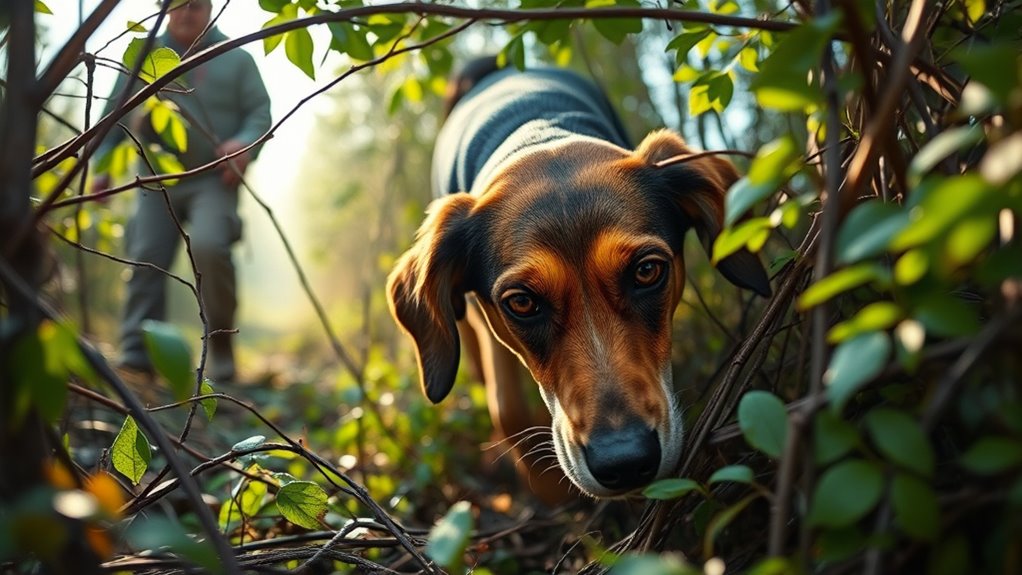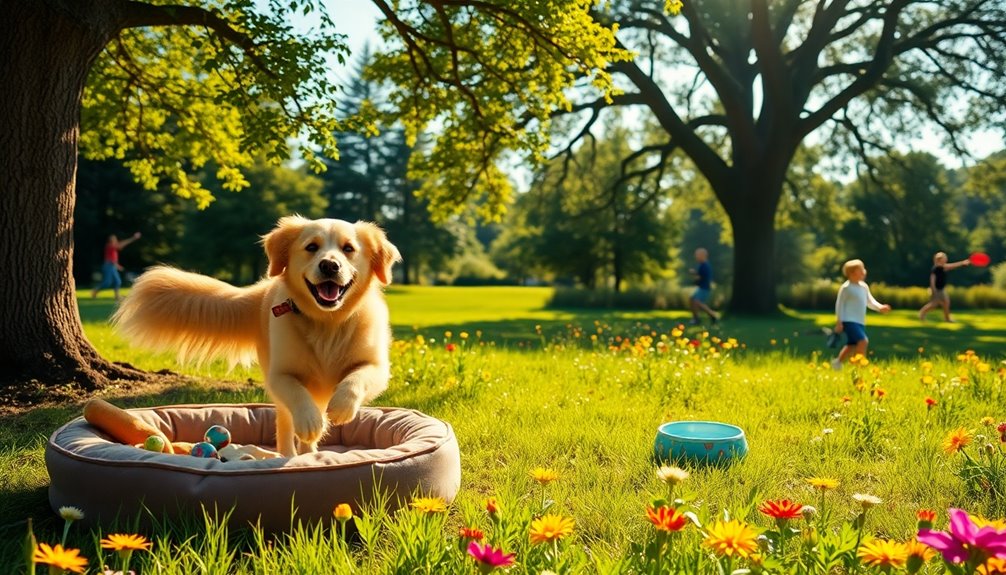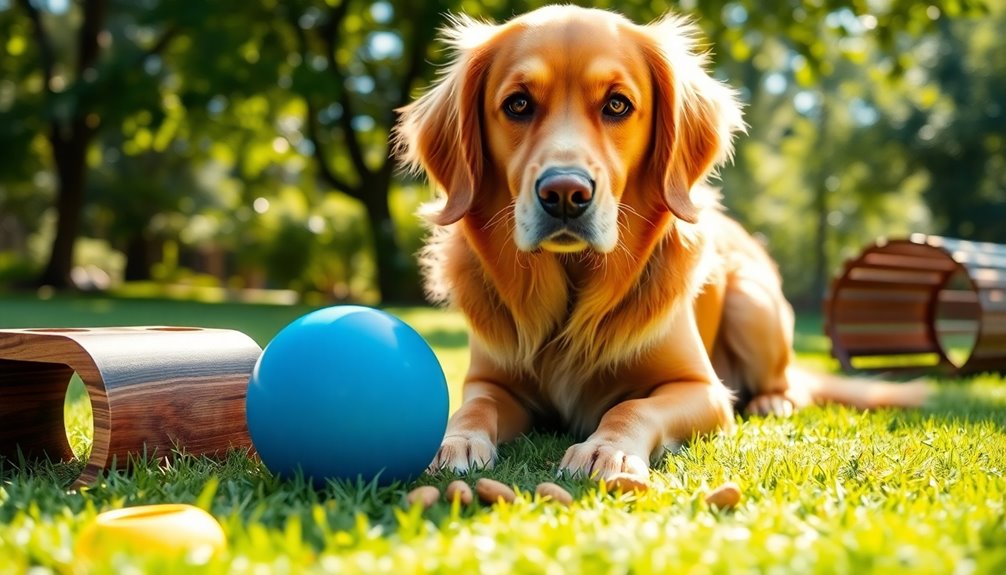Mantrailing is a rewarding search and rescue activity where you use your dog’s incredible sense of smell to find missing people. You’ll start by introducing your dog to scent detection in simple environments, gradually increasing complexity. As you progress, you build your dog’s confidence with longer trails, turns, and obstacles, all while reinforcing their tracking abilities. Keep practicing scent discrimination and varied terrains, and you’ll discover more techniques to make you both successful partners in rescue missions.
Key Takeaways
- Mantrailing involves training dogs to follow a person’s unique scent trail for search and rescue.
- Building confidence and focus is essential for dogs to succeed in complex search environments.
- Gradually increasing trail difficulty and environmental challenges enhances a dog’s tracking skills.
- Positive reinforcement helps motivate dogs and reinforces accurate scent detection and following.
- Scent discrimination exercises improve a dog’s ability to differentiate target scents from distractions.

Mantrailing is a specialized search and rescue technique where trained dogs follow a person’s unique scent trail to locate missing individuals. If you’re interested in teaching your dog this impressive skill, understanding effective training techniques is essential. You’ll want to focus on methods that enhance your dog’s natural scent detection abilities, making them more adept at tracking even in challenging environments. The key to successful mantrailing lies in developing your dog’s confidence and focus during scent work, which begins with consistent, clear training routines.
Start by introducing your dog to dog scent detection. Use a controlled environment to help your dog recognize and differentiate the scent of a specific person. You can do this by marking the scent with a piece of clothing or personal item, then guiding your dog to find it. Reward every successful find to reinforce their tracking behavior. As your dog gets better at recognizing the scent, gradually increase the difficulty by adding more complex trails, varying the terrain, or introducing distractions. This process builds their confidence and sharpens their ability to follow a trail without losing focus.
Begin scent detection training with controlled environments and gradually increase complexity to build confidence and focus.
Training techniques for mantrailing involve a combination of scent imprinting, trail building, and reinforcement. You’ll want to begin with short, straight trails in a familiar setting, ensuring your dog stays engaged and motivated. As they become more proficient, extend the length of the trail and introduce turns or obstacles. During training, always use positive reinforcement—praise, treats, or play—to encourage your dog’s enthusiasm and focus on the task at hand. Keep sessions consistent and goal-oriented, which helps your dog develop a reliable tracking instinct.
Dog scent detection is at the heart of mantrailing. It’s a skill that requires your dog to distinguish a specific scent from other odors in the environment. To improve this skill, practice scent discrimination exercises regularly. For example, hide the target scent in different locations and have your dog find it among other smells. This sharpens their ability to follow a trail and ignore distractions. Over time, these exercises help your dog become more precise and confident in their tracking. Additionally, incorporating training consistency and positive reinforcement techniques can significantly enhance your dog’s scent detection capabilities.
Frequently Asked Questions
What Breeds Are Best Suited for Mantrailing?
Breeds like Bloodhounds, German Shepherds, and Belgian Malinois are best suited for mantrailing because of their breed characteristics, including strong noses and high drive. You’ll find these breeds excel in scent work, though training difficulty varies; Bloodhounds are naturally motivated, while some herding breeds may require more patience. Choose a breed that matches your experience and commitment to training for successful mantrailing adventures.
How Long Does It Take to Train a Dog for Mantrailing?
Training your dog for mantrailing typically takes several months, but the timeline varies based on your dog’s age, breed, and skill development. You should expect consistent training sessions, around 2-3 times a week, focusing on scent work and obedience. With patience and dedication, your dog will develop the necessary skills, and you’ll see progress within a few months. Remember, ongoing practice is key to refining their mantrailing abilities.
Can Older Dogs Learn Mantrailing Skills?
Yes, older dogs can learn mantrailing skills with age-related training and patience. You might need to adapt exercises to suit their energy levels and focus, ensuring they stay motivated. Senior dog motivation is key; use treats, praise, and gentle encouragement to keep their interest. With consistent practice and positive reinforcement, your older dog can develop new skills and enjoy the rewarding experience of mantrailing.
What Equipment Is Essential for Mantrailing Exercises?
Think of your mantrailing journey as a dance, where the right equipment keeps you in sync. You’ll need a sturdy tracking harness to give your dog control and comfort, and scent articles to serve as the trail’s breadcrumbs. These tools help your dog follow the scent trail confidently. With the right gear, you’ll turn your search into a seamless, exciting adventure, building trust and skill with every step.
How Do Weather Conditions Affect a Dog’s Trailing Ability?
Weather conditions markedly impact your dog’s trailing ability, especially with climate change causing unpredictable seasonal variations. Rain, snow, or extreme heat can hinder scent detection, making trails harder to follow. Wind can disperse scents, while humidity can either help or hinder scent particles. To maintain your dog’s effectiveness, adapt training to seasonal changes and be aware of how weather influences scent trails, ensuring safety and success during search and rescue efforts.
Conclusion
So, here you are, relying on your dog’s incredible nose to find lost loved ones, and yet, you might forget that your own sense of direction is pretty much useless in a crisis. Ironically, it’s your furry friend’s natural talent that turns chaos into hope. Next time you’re lost, remember—you’re not the hero; your dog’s nose is. It’s funny how something so simple can make all the difference when everything else seems to fall apart.










